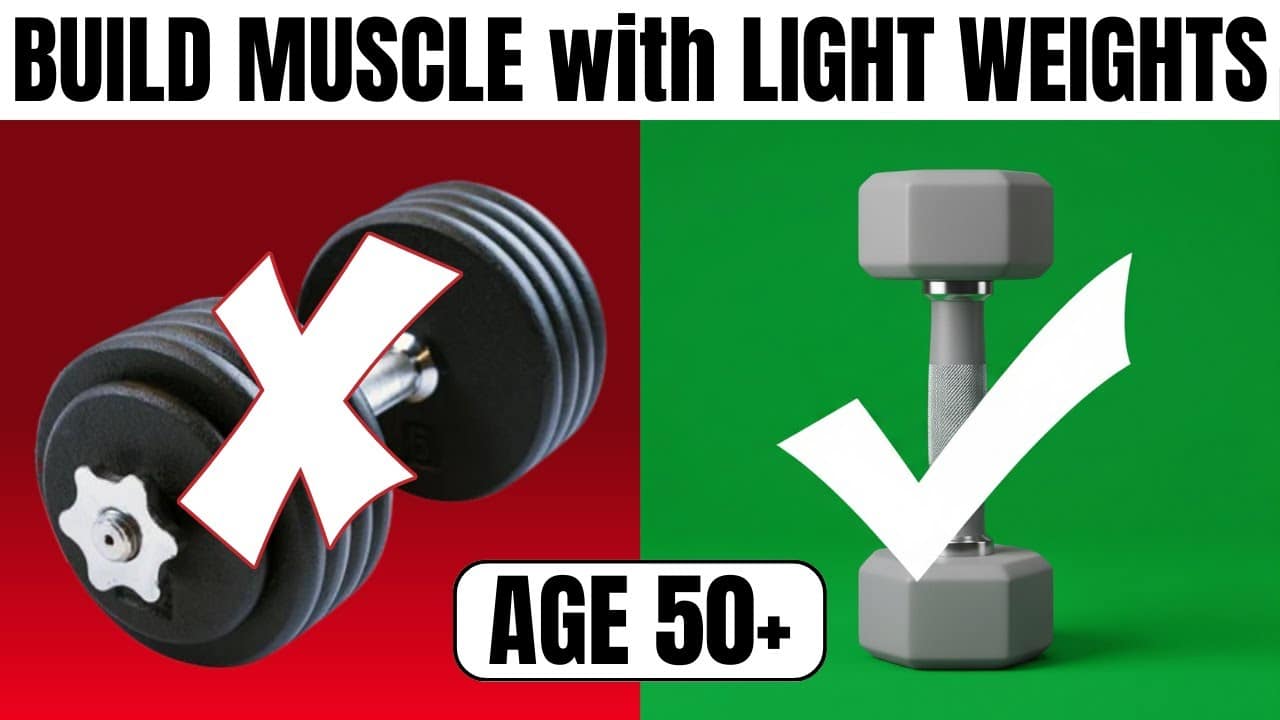If you want to build muscle over 50 but can't lift heavy weights, blood flow restriction training may help. Watch the video to learn about blood flow restriction training for seniors.
What is Blood Flow Restriction (BFR) Training?
Blood flow restriction training uses a cuff placed around the upper arm or thigh.
The cuff partially limits blood flow out of the muscle. Arterial flow still brings blood in.
This creates a low-oxygen state in the muscle. That state helps you build muscle with light loads.
How Blood Flow Restriction Training Works
With BFR, muscles get less oxygen. Slow-twitch fibers fatigue faster under low oxygen.
Your nervous system then recruits more fast-twitch fibers. Fast-twitch fibers drive most muscle growth.
The cuff also traps blood, causing metabolite buildup like lactate and hydrogen ions.
Those chemicals trigger hormonal and cellular responses. Growth hormone and IGF-1 rise after sessions.
These signals activate protein synthesis and satellite cells. That leads to muscle hypertrophy.
In short: light weight plus BFR mimics the biology of heavy lifting.
Scientific Evidence for BFR Over 50
Multiple systematic reviews have tested BFR in older adults.
Key findings
A review of randomized trials found BFR equaled heavy lifting for muscle mass.
Heavy lifting produced slightly more strength gains than BFR.
Both BFR and heavy lifting were better than light training alone.
Mobility and function
A systematic review on gait and mobility showed BFR improved functional tests.
TUG, 6-minute walk, and 400 m walk improved with BFR training.
Gait speed over short distances did not consistently change.
Broader review (50+)
A larger review of adults over 50 found benefits for muscle size, strength, and performance.
Overall, the evidence supports BFR as a useful tool for seniors, especially when heavy lifting is not possible.
How to Do Blood Flow Restriction Training
Here are evidence-based parameters used in trials with older adults.
Strength-style protocol
Use light loads of 20–30% 1RM.
Standard set scheme: 1 × 30 reps, then 3 × 15 reps.
Rest 30 seconds between sets with cuff still inflated.
Use 60–80% limb occlusion pressure (LOP) for legs, and 40–50% for arms.
Keep cuff inflated for the full exercise bout, typically 5–10 minutes per exercise.
Walking protocol
For walking, use lower pressures, ~45–60% LOP.
Walking bouts usually last 10–20 minutes per session.
Frequency in studies ranged from 2 to 5 sessions per week.
Frequency and progression
Most programs used 2–3 sessions per week for strength outcomes.
Start with body weight or very light resistance if you are new to BFR.
BFR for Walking & Other Exercises
BFR works with many exercise types.
Common choices include sit-to-stands, step-ups, seated leg extensions, and band work.
Even walking on a treadmill or hallway with cuffs can improve strength and function.
Walking studies used low speeds and lower pressures and still found benefits.
Is Blood Flow Restriction Training Safe?
It may sound risky, but BFR is safe when used properly.
Typical side effects are muscle soreness and temporary numbness or tightness.
Serious complications are rare in controlled settings.
Safety depends on correct cuff type, accurate pressure, and proper protocol.
Equipment: Choosing the Right BFR Cuffs
Avoid elastic wraps and improvised bands. They are hard to control.
Use pneumatic cuffs with a pressure gauge or SmartCuffs.
SmartCuffs can estimate limb occlusion pressure automatically. Additionally, wider cuffs require lower pressure to reach the same level of occlusion
Investing in proper equipment reduces risk and improves consistency.
Who Should Take Precautions?
Talk to your doctor before trying BFR if you have certain conditions.
Precautions include uncontrolled high blood pressure, history of DVT (blood clots), or peripheral arterial disease.
Also check with a clinician after recent surgery or if you have active cancer.
These conditions do not always rule out BFR, but getting medical advice is advised before starting with blood flow restriction training.
Who Would Benefit From BFR?
BFR helps people who cannot lift heavy due to joint pain or surgery.
It is useful for seniors with arthritis, osteoporosis, or sarcopenia.
It also helps those who need to restore function after injury or surgery.
Even active older adults may use BFR to add hypertrophy without joint stress.
Conclusion & Next Steps
Blood flow restriction training for seniors is a safe, science-backed option.
It helps build muscle with light loads and improves function for many older adults.
If you want to try BFR, start with a trained professional or clinician.
Proper cuffs, correct pressure, and a clear program keep you safe and effective.
Need Help to Build Muscle Safely?
If you live in the St. Louis area, tap the button below to request an appointment.

